











|
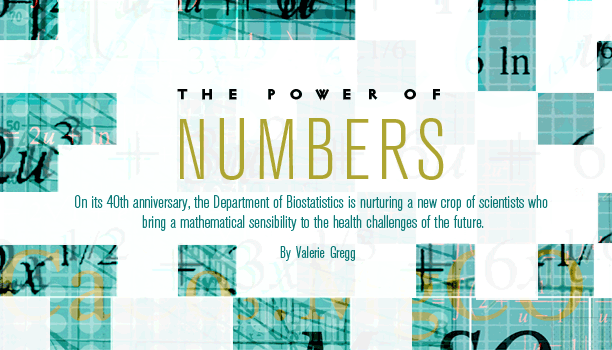 |
| |
|
|
| |
|
|
| |
SEX
IS WHAT FIRST INTERESTED DONNA BROGAN,
when she was an undergraduate at Gettysburg College, the Kinsey
Reports were required reading in psychology.
“I read the chapters, and it
was actually not all that interesting—sexual behavior, blah,
blah, blah,” she says. “What interested me most were
the appendices on statistical methods. One discussed how difficult
it was to get a representative sample of people who would answer
sensitive questions. That was more exciting to me than the book
itself. There was another appendix about the mathematical and statistical
techniques used to analyze the data. That was my first exposure
to statistics and sample surveys, and after that, I was hooked.”
Biostatistics
used to be a man’s career, with men making up the majority
of experts in university departments. However, in the past few decades,
women biostatisticians have found a place of their own in the field.
Brogan, for example, is an internationally known expert in the analysis
and design of sample surveys and a master teacher of those methods.
Her colleagues at the Rollins School of Public Health (RSPH) include
a healthy number of women—Vicki Hertzberg, former chair of
the Department of Biostatistics; Elizabeth Halloran, director of
the Center for Infectious Disease Analysis; Professor Amita Manatunga,
and new recruits such as Lily Zhang and Mary Kelley. More than half
of biostatistics students at the RSPH are now women, and Brogan
has been a force behind the change. She has led movements of female
faculty to fight for equal benefits at both UNC and Emory. Today,
she continues to speak up for women, serving on committees of the
American Statistical Association to promote women in the field.
|
|
| |
|
|
| |
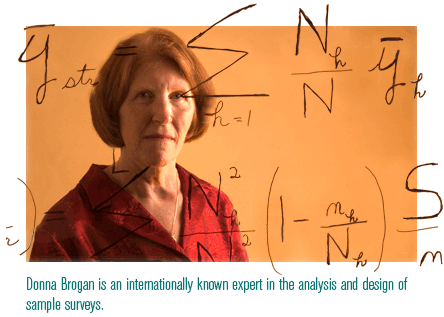 |
|
| |
|
|
| |
Brogan has not been alone in shaping
the course of biostatistics at Emory. The same week she arrived
on campus as an associate professor in 1971 so did Michael Kutner.
Brogan, never a shrinking violet, got there first and chose the
biggest office in Uppergate House, then home to the Department of
Biometry at Emory School of Medicine. She and Kutner joined four
other doctoral faculty, who provided statistical services for medical
school investigators.
Today, Brogan has retired, and Kutner
remains as the Rollins professor and chair of the Department of
Biostatistics, which recently celebrated its 40th anniversary. What
Kutner remembers most about the early days in the department are
the cards—stacks and stacks of punched IBM computer cards
that held statistical answers to questions of health and disease.
“What took hours then takes seconds now,” he says. “Technology
has changed our field incredibly because of advanced computing speed
and technology.”
During the past 40 years, the department
has changed in more ways than gender diversity. It is formidable
not only in size with 19 doctoral faculty, but also in talent. Last
year, it recruited seven new doctoral faculty, two of them senior
appointments with key areas of expertise.
“We used to have a mission to
be the best biostatistics department in the South,” says Kutner.
“Now we’re aiming to be up there with the best in the
country. And if we can keep pace with all that’s happened
in just 40 years, I think we can get there.”
As in its early days, the department
still has a strong emphasis on collaborating with faculty in public
health and medicine and participating in national and international
studies. Indeed, good biostatistics is a foundation for studies
in any area of medicine and health. The RSPH biostatistics department
focuses on methodologic research as well. “We are ramping
up our research capability,” says Kutner. “That’s
why we’re hiring people and why we’re hiring primarily
research-oriented faculty.” |
|
| |
|
|
| |
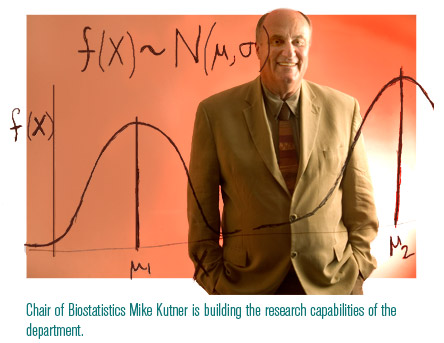 |
|
| |
|
|
| |
POWERHOUSE
TALENTS |
|
| |
When
Andre Rogatko and Eugene Huang arrived on campus this past year,
there was no haggling over office space. They were both esteemed
senior faculty members with well-established research records in
two key areas of study—cancer and HIV, respectively.
Rogatko, who is a Georgia Cancer Coalition
Scholar, holds joint appointments—as professor of biostatistics
at the RSPH, professor of hematology and oncology at Emory School
of Medicine, and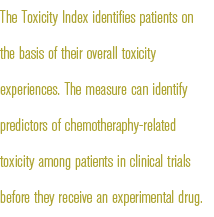 associate director for biostatistics research and informatics at
the Winship Cancer Institute. He is central to the expanding role
that the RSPH is playing at Winship, which has a planning grant
from the NCI to work toward status as a comprehensive cancer center.
These federally designated centers garner funding, cachet, and the
latest technology and clinical trials. “Biostatistics is a
key element to achieving this status,” says Kutner. “They
need an outstanding biostatistics core to successfully compete,
and Dr. Rogatko is making that happen.”
associate director for biostatistics research and informatics at
the Winship Cancer Institute. He is central to the expanding role
that the RSPH is playing at Winship, which has a planning grant
from the NCI to work toward status as a comprehensive cancer center.
These federally designated centers garner funding, cachet, and the
latest technology and clinical trials. “Biostatistics is a
key element to achieving this status,” says Kutner. “They
need an outstanding biostatistics core to successfully compete,
and Dr. Rogatko is making that happen.”
Former chair of the biostatistics
department at Fox Chase Cancer Center, Rogatko has special expertise
in statistical methods involving clinical trial design and genetic
epidemiology. “Cancer is not like all other areas of research,”
he says. “The patients in our studies often are severely ill,
and we have to be especially careful of their fragile health in
clinical trials.”
|
|
| |
|
|
| |
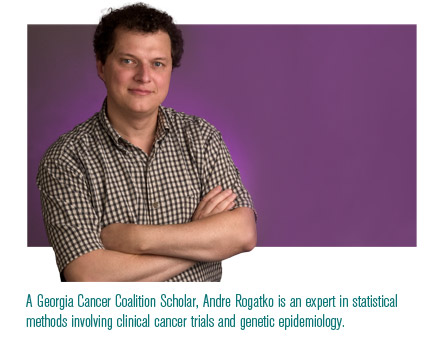
|
|
| |
|
|
| |
He has developed statistical methods
to adjust doses of experimental cancer drugs to patient-specific
characteristics, allowing doses to be escalated as quickly as possible
while safeguarding against overdose. Four FDA-approved phase I studies
have adopted his methods. He also has developed a new summary measure
called the Toxicity Index to identify patients on the basis of their
overall toxicity experiences. This measure can identify predictors
of chemotherapy-related toxicity among patients in clinical trials
before they receive an experimental drug.
Huang, associate professor of biostatistics,
strengthens the RSPH research footing in HIV and cancer as well
as in outcomes research. Recruited in 2004 from the Fred Hutchinson
Cancer Research Center, Huang conducts statistical methodology research
focused on survival analysis and covariate measurement error. He
has collaborated with medical investigators in HIV/AIDS prevention
and treatment studies and in cancer.
|
|
| |
|
|
| |
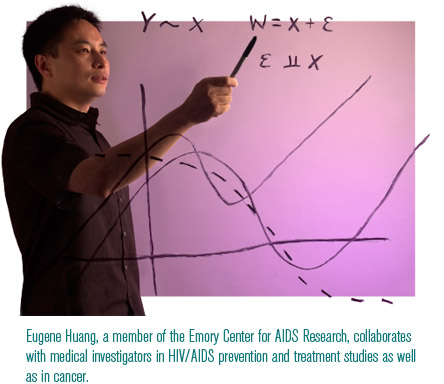 |
|
| |
|
|
| |
“My
methods research deals with incomplete or inaccurate observations
of outcomes and/or predictors,” he says. “Follow-up
data typically are incomplete in clinical studies. Covariate data
like CD4 count and viral load in HIV studies and blood pressure
in heart disease may be subject to measurement error.” Huang
has developed statistical methods to analyze medical cost and quality
of life with incomplete follow-up data and to address covariate
measurement error with several commonly used regression methods.
Huang and Rogatko, both esteemed in
their fields, add to an already impressive department record. Longtime
professors Ira Longini and Elizabeth Halloran are internationally
known for developing statistical theories to predict disease transmission
and progression. They have worked with the CDC to help plan vaccination
strategies for influenza. After the bioterrorist attacks in the
fall of 2001, they adapted these strategies to help CDC plan for
the threat of bioterrorism using smallpox. More recently, they are
contributing their expertise to the interdisciplinary Center for
Infectious Disease Analysis, applying statistical modeling to some
of today’s most challenging epidemics, including cholera,
influenza, and SARS.
Other faculty members are bringing
the power of numbers to a gamut of areas: Michael Haber in infectious
diseases, Amita Manatunga in genetic studies, and John Hanfelt and
Robert Lyles in epidemiologic studies. |
|
| |
|
|
| |
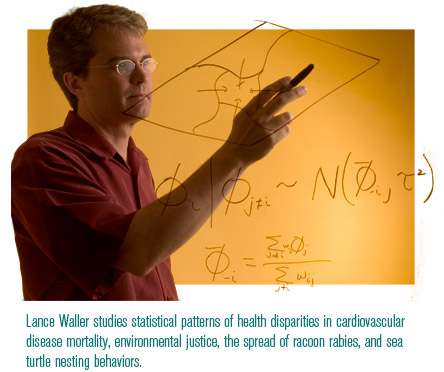
|
|
| |
|
|
| |
THE
NEW DEMOGRAPHIC |
|
| |
Thanks
to an endowment from the Rollins Foundation three years ago, the
biostatistics department has new endowed assistant professorships
that are attracting some of the best and the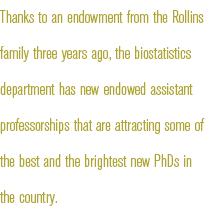 brightest new PhDs in the country. “These junior faculty are
key to the department’s future as a methodologic biostatistics
research center,” Kutner says. “They are our future.”
brightest new PhDs in the country. “These junior faculty are
key to the department’s future as a methodologic biostatistics
research center,” Kutner says. “They are our future.”
Additionally, new hires during the
past five years have added breadth and depth to biostatistics at
Emory. Lance Waller, for example, studies statistical patterns of
health disparities in cardiovascular disease mortality, environmental
justice, the spread of raccoon rabies, and sea turtle nesting behaviors.
F. DuBois Bowman specializes in applying statistical methods to
medical imaging studies, including PET scans of the brain.
|
|
| |
|
|
| |
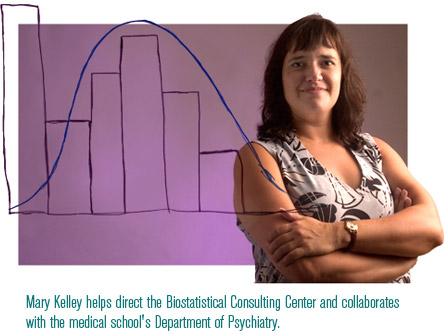 |
|
| |
|
|
| |
Although
many new faculty are working solely on perfecting statistical methods
and analysis, many continue helping scientists across the Woodruff
Health Science Center design and interpret studies and clinical
trials. Recent recruit Mary Kelley is assistant director of the
Biostatistical Consulting Center (BCC) and research assistant professor
of biostatistics. Previously, she was a statistical consultant at
the University of Pittsburgh, where she worked on landmark mental
health studies involving schizophrenia and depression.
“I wear many hats here at Emory,”
she says. “I am teaching a statistical computing course, I
help direct the BCC, and I serve as departmental statistician for
the Department of Psychiatry in the medical school. With a large
number of ongoing studies, they need a lot of help managing and
analyzing data. I also conduct seminars to train their faculty and
fellows in statistical methods.”
She came to Emory, she says, for the
opportunity to teach and work with eminent scientists. “The
opportunities for my own personal growth as a biostatistician are
enormous here,” Kelley says. “I’ve found myself
in a pretty good place—up and coming. Really the sky is the
limit.”
Valerie
Gregg is a freelance writer in metropolitan Atlanta and the former
editor of this magazine.
|
|
| |
|
|
| |
|
|
|
|
|
|

